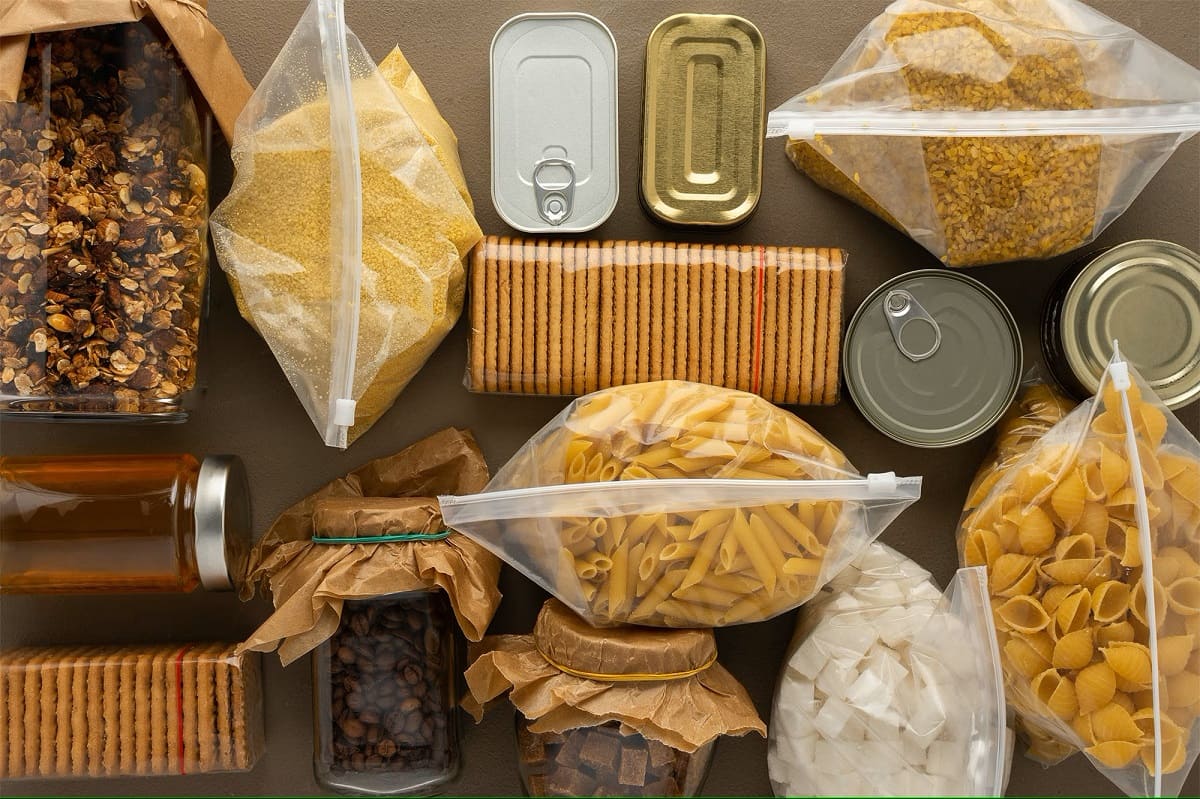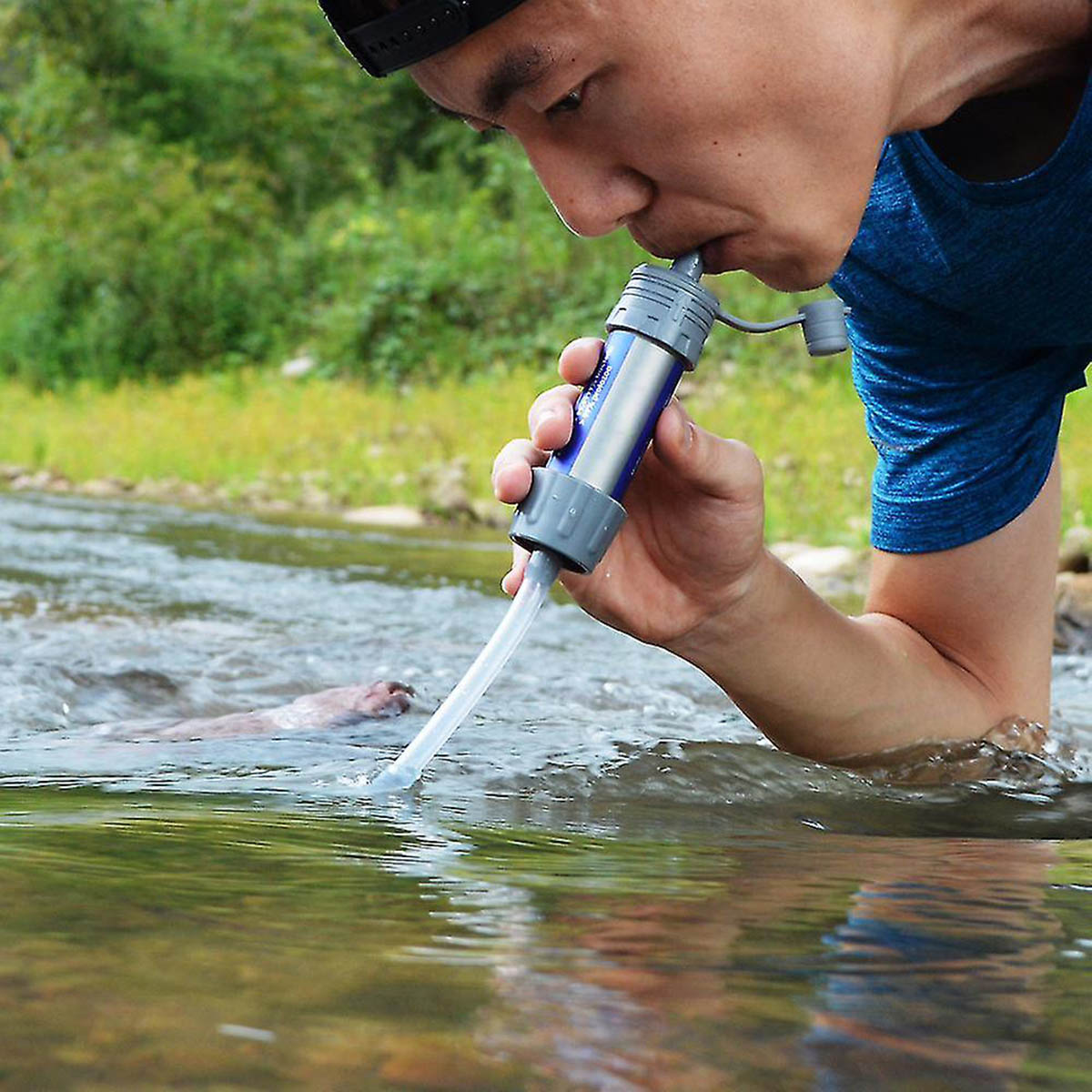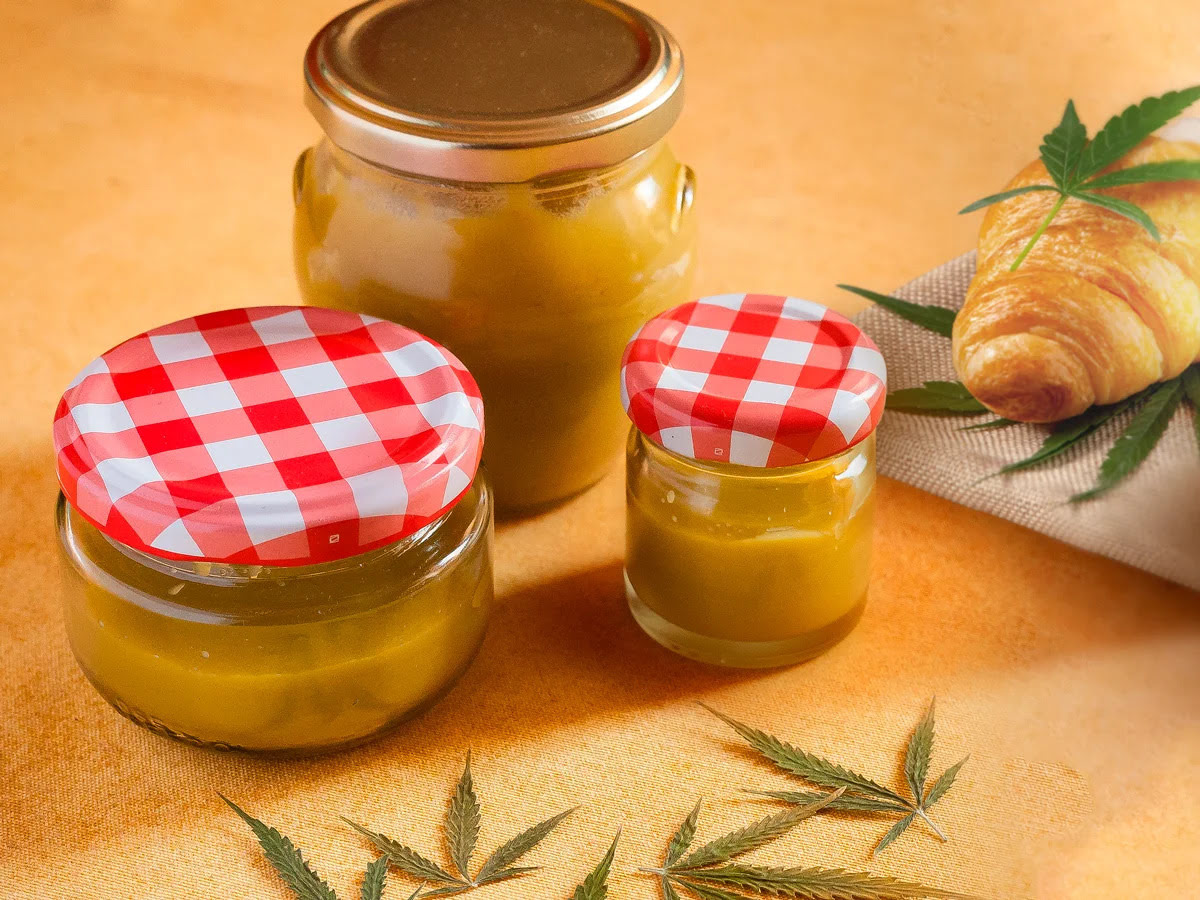

Articles
How To Store Food For Survival
Modified: January 5, 2024
Learn essential techniques and tips on how to store food for survival in this comprehensive collection of articles. Ensure your preparedness with expert advice and guidance.
(Many of the links in this article redirect to a specific reviewed product. Your purchase of these products through affiliate links helps to generate commission for Storables.com, at no extra cost. Learn more)
Introduction
When it comes to preparing for emergencies or uncertain times, one of the most crucial aspects is ensuring an adequate food supply. Food storage for survival is a fundamental component of any preparedness plan, ensuring that you and your loved ones have access to nourishing meals during times of crisis or when access to fresh food is limited.
Understanding the importance of food storage for survival is paramount to ensuring your overall preparedness. In this comprehensive guide, we will explore various key considerations and strategies to help you effectively store food for survival.
From natural disasters such as hurricanes or earthquakes to socio-economic disruptions, life can throw unexpected challenges our way. Having a well-prepared and stocked food storage can provide peace of mind, knowing that you are prepared to weather any storm.
In this article, we will explore important steps to take when it comes to storing food for survival. We will delve into assessing your food needs, choosing the right storage containers, properly packaging your food, selecting suitable storage locations, implementing rotation systems, storing water for long-term survival, managing temperature and humidity, keeping pests and rodents away, and monitoring and replenishing supplies.
By following these guidelines and incorporating them into your preparedness strategy, you will be well-equipped to face any unexpected situation with confidence and ensure the well-being of you and your family.
Key Takeaways:
- Building and maintaining a food storage system for survival is crucial for emergency preparedness. Understanding food needs, proper packaging, and rotation systems are key to ensuring a reliable and well-rounded food supply.
- Storing water, managing temperature and humidity, and keeping pests away are essential components of a successful food storage plan. Regular monitoring and replenishment of supplies are vital for maintaining a fresh and diverse stockpile.
Read more: How To Survive A Home Renovation
Understanding the Importance of Food Storage for Survival
When it comes to surviving in an emergency or crisis situation, having access to an adequate food supply is essential. Understanding the importance of food storage for survival is the first step toward being prepared for any unforeseen events.
During times of crisis such as natural disasters, civil unrest, or even personal emergencies, the availability and accessibility of food can be severely compromised. Supermarkets may run out of supplies, transportation systems may be disrupted, and access to fresh food may become limited or non-existent. This is where having a well-stocked food storage comes into play.
Having a sufficient food supply can provide you and your family with sustenance and peace of mind during prolonged periods without access to grocery stores or restaurants. It ensures that you have the necessary nutrition to sustain yourselves, especially in situations where you may not have access to electricity or other essential resources.
Additionally, having a food storage for survival allows you to take control of your own well-being, reducing reliance on external factors and increasing self-sufficiency. Rather than relying solely on the availability of food in the market, you can create a stockpile of essentials that are tailored to your dietary needs and preferences.
Food storage can also provide a sense of comfort and stability during uncertain times. Knowing that you have a supply of food that can sustain you and your loved ones for an extended period of time can alleviate anxiety and allow you to focus on other necessary tasks or challenges that may arise.
Furthermore, having a food storage can be a cost-effective approach to meal planning and budgeting. By purchasing food in bulk or during sales and storing it for future use, you can save money in the long run. It also provides a buffer against inflation or price increases during times of economic instability.
Ultimately, understanding the importance of food storage for survival is about being proactive and taking responsibility for your own well-being. It allows you to ensure that you and your family have access to nourishing meals and are prepared for any emergency or crisis situation that may arise.
Assessing Your Food Needs
Before you start building your food storage for survival, it’s important to assess your food needs based on the number of people in your household, their dietary restrictions, and the duration you want your food supply to last. By properly understanding and estimating your food requirements, you can ensure that you have enough food to sustain your family during an emergency.
Start by determining the number of people you need to provide for. Take into account family members, including children, elderly individuals, and any individuals with special dietary needs. Consider factors such as daily caloric requirements, nutrient intake, and any specific dietary restrictions or allergies.
Next, calculate the duration for which you want your food storage to last. It is recommended to have at least a three-month supply of food, but you may choose to store more if you anticipate longer periods of disruption or if you wish to be prepared for an extended emergency.
When estimating your food needs, it’s important to consider a variety of food groups to ensure a well-rounded and balanced diet. Include items from all major food categories, such as grains, legumes, proteins, fruits, vegetables, and dairy or dairy alternatives. Aim for a mix of shelf-stable items, such as canned goods and dry goods, as well as foods with longer shelf lives, such as freeze-dried or dehydrated options.
Take into consideration the preferences and eating habits of your family members. Store foods that you and your loved ones enjoy and are familiar with, as this will help maintain morale and provide a sense of normalcy during challenging times. However, also be open to trying new foods and exploring options that have longer shelf lives and higher nutritional value.
Consider any special needs or medical conditions that may require specific dietary considerations. If someone in your family has food allergies or requires a specialized diet, make sure to include the necessary items in your food storage. It’s also important to have a sufficient supply of any required medications or medical supplies.
Regularly review and update your food storage plan to account for any changes in your household, such as the addition of new family members or changes in dietary needs. Periodically rotate through your food supply to ensure that items are still within their expiration dates and maintain their quality.
By carefully assessing your food needs and tailoring your storage plan accordingly, you can ensure that you have a well-rounded and sufficient food supply to sustain yourself and your family during challenging times.
Choosing the Right Storage Containers
Selecting appropriate storage containers is a crucial step in building an effective food storage system. The right containers can help protect your food from moisture, pests, and other external factors, ensuring its longevity and maintaining its quality over time. Here are some factors to consider when choosing the right storage containers for your food storage:
1. Material: Opt for containers made from food-grade materials such as BPA-free plastic, glass, or metal. These materials are safe for storing food and do not pose any health risks. Avoid using containers that may leach harmful substances into your food.
2. Airtightness: Look for containers that provide a secure and airtight seal. This helps to prevent moisture, air, and insects from entering the container and causing spoilage. Airtight containers can help extend the shelf life of your food and maintain its freshness.
3. Durability: Choose containers that are sturdy and durable. They should be able to withstand the weight and pressure of stacked containers and resist breaking or cracking over time. A durable container will ensure that your food remains protected and intact.
4. Stackability: Consider the space available for your food storage and select containers that are stackable. This maximizes storage efficiency and makes it easier to organize and access your supplies. Stackable containers also help to optimize space utilization in small pantries or storage areas.
5. Size and Shape: Choose containers of varying sizes to accommodate different types of food items. It’s preferable to have containers in multiple sizes to avoid excessive empty space within the container, which can lead to quicker spoilage. Additionally, consider the shape of the containers to ensure they fit well on your shelves or in your storage space.
6. Light Protection: Opt for containers that are opaque or UV resistant to protect your food from exposure to light. Light can degrade certain nutrients and cause food to spoil more quickly. Dark-colored or light-blocking containers help to preserve the quality and nutritional value of the stored food.
7. Easy to Clean: Look for containers that are easy to clean and maintain hygiene standards. Containers with smooth surfaces and removable lids allow for thorough cleaning and help prevent the growth of bacteria or mold.
8. Labeling: Consider containers that have an area or space for labeling. This allows you to easily identify the contents and expiration dates of the stored food, enabling you to maintain an organized and efficient rotation system.
By carefully considering these factors and selecting the right storage containers, you can ensure that your food storage remains secure, organized, and protected for long-term survival.
Properly Packaging Your Food
Properly packaging your food is essential for maintaining its quality and extending its shelf life in your survival food storage. This step involves protecting your food from moisture, air, pests, and other environmental factors that can lead to spoilage. Here are some tips for properly packaging your food:
1. Use Airtight Containers: Store your food in airtight containers that provide a secure seal. This helps to prevent oxygen and moisture from reaching the food, which can cause it to deteriorate quickly. Vacuum-sealed bags or containers with locking lids are ideal for maintaining the freshness and integrity of your stored food.
2. Utilize Mylar Bags: Mylar bags are an excellent option for long-term food storage. They are durable, light-blocking, and provide an extra layer of protection against oxygen and moisture. Use oxygen absorbers to remove any remaining oxygen in the bags before sealing them tightly.
3. Consider Food-Safe Buckets: For bulk storage of items such as grains, beans, or flour, consider using food-safe buckets with airtight lids. These buckets are designed to withstand long-term storage, keeping your food safe from pests and contaminants. Place a sealed Mylar bag inside the bucket for added protection.
4. Repackage Bulk Items: For items purchased in bulk, consider repackaging them into smaller, more manageable quantities. This reduces the exposure of the entire supply to air and moisture each time you open the container. Use appropriately sized containers or Mylar bags to extend the shelf life of the repackaged food.
5. Label and Date: Label each package or container with the contents and the date of storage. This helps you keep track of the age of your stored food and implement a proper rotation system. Use a permanent marker or labels that adhere well to the packaging.
6. Store in Cool, Dark Places: Choose a cool, dry, and dark location for storing your food. Avoid areas that are prone to temperature fluctuations, as this can accelerate the deterioration of food. Direct exposure to sunlight should be avoided to prevent the loss of nutrients and quality degradation.
7. Consider Freezing or Dehydrating: Some foods can be preserved by freezing or dehydrating. Freezing can help maintain the quality of fruits, vegetables, and meat, while dehydration is suitable for items like herbs, jerky, or fruits. Follow proper freezing or dehydrating techniques to ensure optimal results.
8. Regularly Inspect and Replace Packaging: Periodically inspect your food storage for any signs of damage or compromised packaging. Replace damaged containers or packaging to maintain the integrity of your stored food. Monitor expiration dates and rotate through your supply accordingly.
Properly packaging your food is crucial for maintaining its nutritional value and ensuring its safety for consumption during a survival situation. Following these packaging tips will help you maximize the shelf life of your stored food and be better prepared for any emergencies that may arise.
Read more: How To Survive A Kitchen Renovation
Selecting Suitable Storage Locations
Choosing the right storage locations for your survival food is essential to ensure optimal conditions for long-term preservation. The storage locations should protect your food from environmental factors, such as temperature fluctuations, high humidity, and exposure to light. Here are some considerations when selecting suitable storage locations:
1. Cool and Dry Areas: Opt for storage areas that are cool and dry, as these conditions help extend the shelf life of your food. Aim for temperatures between 50 to 70 degrees Fahrenheit (10 to 21 degrees Celsius) and humidity levels below 15-20%. Avoid areas prone to extreme temperature changes or high humidity, such as the attic or basement.
2. Dark and Light-Free: Choose storage locations that are dark or offer minimal exposure to light. Light can degrade certain nutrients and cause food to spoil more quickly. Utilize shelves, cabinets, or pantries that don’t receive direct sunlight. Consider using blackout curtains or covering windows to block out light if necessary.
3. Adequate Ventilation: Ensure that the storage area has proper ventilation to prevent the accumulation of moisture or the development of mold. Good airflow can help maintain dry conditions and prevent the growth of bacteria or pests. Avoid storing food in airtight spaces without any airflow.
4. Pest-Free Environments: Select areas that are free from pests such as rodents, insects, or ants. Ensure that there are no entry points for pests to access your food storage. Use pest control measures such as sealing cracks, installing screens on windows, and using traps or deterrents if needed.
5. Elevated Storage: Whenever possible, store your food off the ground to protect it from potential moisture and pests. Use shelves, pallets, or risers to elevate your food storage containers. This prevents any ground-level issues and provides better air circulation and easy access to your supplies.
6. Accessibility: Consider the ease of access when selecting storage locations. Ensure that you can easily reach your food supplies and rotate them as necessary. Avoid placing heavy items or large volumes of food in hard-to-reach areas, as this can make it challenging to manage and replenish your stockpile.
7. Security: Prioritize the security of your food storage. Choose locations that are protected from potential theft or damage. If possible, consider locking or securing the storage area to prevent unauthorized access. This will help ensure that your food supply remains intact and ready for emergencies.
8. Protect from Disasters: Keep in mind the potential risks of natural disasters in your area. Avoid storing your food in areas prone to flooding, earthquakes, or other potential disasters. If necessary, take additional precautions such as storing your food in waterproof containers or elevating it above potential water levels.
By selecting suitable storage locations, you can create an environment that preserves the quality and longevity of your survival food supply. Regularly monitor the storage conditions and ensure proper maintenance to keep your food storage intact and ready for any emergency situation.
Store food in a cool, dark, and dry place to extend its shelf life. Use airtight containers or vacuum-sealed bags to prevent spoilage and keep pests out. Rotate your stock to ensure you use the oldest items first.
Implementing Rotation Systems
Implementing a rotation system for your survival food storage is crucial to ensure that your food remains fresh and safe for consumption. By rotating through your stockpile, you can use older items before they expire and replenish with fresh supplies. Here are some key steps to implement an effective rotation system:
1. First In, First Out (FIFO): Use the “First In, First Out” principle to ensure that older items are consumed first. When organizing your food storage, place newer items behind older ones. This way, you will naturally reach for the items that have been in storage the longest, minimizing the risk of spoilage or wasting food.
2. Date and Label Items: Label each container or package with the date of storage. Clearly mark the expiration date or recommended use-by date of the food item. This makes it easier to track the age of your stored food and identify items that need to be consumed or replaced.
3. Regularly Check and Inspect: Regularly inspect your food storage to check for any signs of spoilage, damage, or expired items. Discard any items that have passed their expiration date or show signs of deterioration. Conduct periodic inventory checks to ensure that your stockpile is up-to-date and properly managed.
4. Build Meals around Stored Foods: Plan your meals and incorporate the food from your survival storage into your regular meal rotation. This helps you become familiar with the taste and preparation of stored foods and ensures that you are regularly consuming and replacing them. Incorporate a variety of items from your stockpile to maintain a balanced diet.
5. Regularly Consume and Replace: Establish a schedule to consume and replace items in your food storage. Consider setting reminders or marking specific months for reviewing and replenishing your supplies. Aim to consume stored items before their expiration date and replace them with fresh items as needed.
6. Donation or Charity: If you find yourself with excess food that is nearing its expiration date and cannot be consumed in time, consider donating it to food banks or charitable organizations. This ensures that the food doesn’t go to waste and helps those in need.
7. Education and Training: Familiarize yourself and your family members with the rotation system and the importance of consuming stored foods in a timely manner. Train everyone on how to identify signs of spoilage or expiration. Make it a shared responsibility to monitor and rotate through the food supplies.
8. Keep an Inventory: Maintain an inventory of your food storage, either physically or digitally. This allows you to keep track of what you have on hand, plan meals accordingly, and identify items that need to be consumed or replaced.
By implementing a rotation system, you can ensure that your survival food storage remains fresh, nutritious, and ready for consumption during emergencies. Regularly monitoring and replenishing your supplies helps you stay prepared and maximize the efficiency of your food stockpile.
Storing Water for Long-term Survival
Water is essential for human survival, and having a reliable supply of safe drinking water is crucial during emergencies or prolonged periods without access to clean water sources. Here are some key considerations for storing water for long-term survival:
1. Calculate Water Needs: Determine the amount of water needed for your household during an emergency. The general recommendation is to store at least one gallon (3.8 liters) of water per person per day for drinking and sanitation purposes. Take into account the number of people in your household and the estimated duration of the emergency.
2. Use Appropriate Containers: Store water in food-grade containers that are specifically designed for water storage. Look for containers made of BPA-free plastic, glass, or stainless steel. Avoid using containers that previously held non-food substances, as they may contaminate the water.
3. Clean and Sanitize Containers: Before filling the containers, thoroughly clean them with soap and water. Rinse thoroughly to remove any residue. To sanitize the containers, mix a solution of one teaspoon of unscented bleach per gallon of water and use it to rinse the inside of the containers. Let the containers air dry before filling them with water.
4. Choose a Cool and Dark Storage Location: Store water in a cool, dark place away from direct sunlight. Exposure to heat and sunlight can degrade the quality of stored water and potentially promote the growth of algae or bacteria. Avoid storing water near chemicals or other substances that may contaminate it.
5. Rotate Water Supply: Regularly rotate your water supply to ensure its freshness. It is recommended to replace stored water every six months. Use the older water for household purposes such as cleaning or gardening to avoid waste, and replace it with fresh water for drinking and cooking.
6. Consider Water Purification Methods: In addition to stored water, it is wise to have water purification methods on hand in case your supply runs out or becomes contaminated. Stock up on water purification tablets, water filters, or a means to boil water, such as a stove or portable camping stove.
7. Store Water in Multiple Locations: Distribute your stored water across different locations in case one area becomes inaccessible or compromised. This ensures that you have access to water even if there are localized issues such as leaks or damage.
8. Educate Yourself on Local Water Sources: Familiarize yourself with local water sources such as nearby rivers, lakes, or underground wells. Know the proper ways to filter or purify water from these sources in case you need to supplement your stored water supply.
9. Regularly Monitor and Test: Periodically check your stored water for any signs of contamination or degradation, such as unusual odors, discoloration, or a strange taste. If you suspect any issues, discard the water and disinfect the containers before refilling them.
By following these guidelines, you can ensure that you have a reliable and safe water supply for long-term survival. Remember to store enough water to meet your needs, keep it properly stored and rotated, and have backup purification methods in case your supply becomes compromised or depleted.
Managing Temperature and Humidity
Properly managing the temperature and humidity of your survival food storage is crucial for maintaining the quality and longevity of your stored food. Extreme temperature fluctuations and high humidity levels can accelerate the spoilage and degradation of food. Here are some essential tips for managing temperature and humidity in your storage area:
1. Temperature Control: Aim to store your food in an area with a consistent cool temperature, ideally between 50 to 70 degrees Fahrenheit (10 to 21 degrees Celsius). Avoid locations that are subject to extreme heat or cold, such as near heating appliances or in unheated garage spaces. Fluctuations in temperature can negatively affect the quality and shelf life of your food.
2. Use a Thermometer: Install a thermometer in your storage area to monitor the temperature accurately. Regularly check the thermometer to ensure that the desired temperature range is maintained. This helps you identify any temperature fluctuations that may require adjustments in your storage location or improvements in temperature control measures.
3. Insulate and Ventilate: Insulate your storage area to help stabilize the temperature. Proper insulation can better regulate temperature changes caused by external factors. Additionally, ensure adequate ventilation to allow for proper air circulation and prevent the buildup of moisture or stagnant air. This helps to reduce the risk of mold or bacterial growth.
4. Use Climate-Controlled Storage: If possible, consider using climate-controlled storage options such as a cellar, basement, or climate-controlled pantry. These areas offer more stable temperature and humidity levels. If using a basement, be cautious of potential moisture or flooding issues and take appropriate preventive measures.
5. Dehumidify Humid Environments: In areas with high humidity levels, use dehumidifiers to reduce moisture. Excessive moisture can create a breeding ground for mold, mildew, and bacteria. Ensure that the dehumidifier is properly maintained and emptied regularly for optimal performance.
6. Monitor and Control Humidity Levels: Use a hygrometer to measure and monitor the humidity levels in your storage area. Aim for a humidity range of 40% to 50% to prevent excess moisture that can lead to food spoilage. If humidity levels are consistently high, consider using moisture absorbers or desiccant packs to reduce moisture.
7. Avoid Condensation: Condensation can promote the growth of mold and compromise the quality of your stored food. Ensure that containers and lids are completely dry before sealing them. Avoid introducing moist or warm items into the storage area, as they can create condensation when they come into contact with cooler surfaces.
8. Regularly Check for Signs of Moisture: Conduct regular inspections of your storage area for any signs of moisture, water leaks, or condensation buildup. Address any issues promptly to prevent further damage to your food. Wipe down surfaces if necessary and consider using moisture-absorbing materials like silica gel packs or moisture absorber products.
9. Consider Silica Gel Packs: Place silica gel packs in containers or storage areas to help absorb any excess moisture. These packs are designed to control humidity levels and can be found in various sizes and quantities. Be sure to use food-grade silica gel packs that are safe for contact with food.
By implementing these temperature and humidity management practices, you can create an environment that helps preserve the quality and integrity of your stored food. Regular monitoring, control, and preventive measures will go a long way in ensuring that your survival food storage remains in optimum condition for long-term use.
Read more: How To Survive Guarana Seeds
Keeping Pests and Rodents Away
When it comes to storing food for long-term survival, one of the biggest challenges is keeping pests and rodents away. These unwanted visitors can quickly contaminate your food supply and compromise your efforts for preparedness. Here are some strategies to effectively keep pests and rodents away from your survival food storage:
1. Store in Airtight Containers: Use airtight containers to store your food. This prevents pests and rodents from accessing the food and helps maintain its freshness. Containers with locking lids or containers that can be sealed with tape or plastic wrap are highly recommended.
2. Inspect Food Before Storage: Before placing food items into storage, inspect them for signs of pests or infestation. Look for any evidence of bugs, larvae, or rodent droppings. If you notice any signs of infestation, discard the affected items and thoroughly clean the storage area before restocking.
3. Clean Storage Area: Ensure that the storage area is clean and free from food debris. Regularly sweep, vacuum, and wipe down shelves or cabinets to prevent crumbs or spills that may attract pests. Keep the area well-maintained and eliminate any potential hiding spots for pests.
4. Seal Entry Points: Seal any possible entry points where pests or rodents can gain access to your storage area. Ensure that doors and windows are properly sealed, and check for any gaps, cracks, or openings in walls or floors. Use caulk, weatherstripping, or other appropriate materials to seal these entry points.
5. Store Food Off the Ground: Elevate your food storage containers off the ground to discourage pests and rodents. Use pallets, shelves, or other raised platforms to keep your supplies secure and prevent access from crawling pests.
6. Utilize Pest Deterrents: Consider using natural pest deterrents such as peppermint oil, bay leaves, or citrus peels placed around the storage area. These scents are known to deter pests and rodents. Additionally, electronic pest repellent devices, traps, or bait stations may be effective in preventing infestations.
7. Regularly Inspect and Monitor: Conduct regular inspections of your food storage area to check for any signs of pest activity. Look for droppings, gnawed containers, or chewed packaging. If you notice any signs of pests or rodents, take immediate action to eliminate them and secure your food supply.
8. Don’t Forget about Exteriors: While securing the storage area is critical, don’t forget about the exterior surroundings. Keep outdoor areas clean and tidy, ensuring that bins, garbage, and compost are properly sealed. Trim vegetation away from the storage area to discourage pests from approaching.
9. Educate and Involve Everyone: Educate all household members about the importance of preventing pest and rodent infestation in the food storage area. Emphasize good sanitation practices, proper handling of food, and the significance of promptly reporting any signs of pest activity.
10. Professional Pest Control: If you are facing severe pest or rodent problems that you cannot handle on your own, consider seeking help from professional pest control services. They can assess the situation, provide effective solutions, and help prevent further infestations.
By implementing these pest prevention strategies and staying vigilant, you can protect your survival food storage from pests and rodents. Regular maintenance, cleanliness, and proactive measures will help ensure that your food supply remains safe and uncontaminated for long-term survival.
Monitoring and Replenishing Supplies
Monitoring and replenishing your survival food supplies is crucial to ensure that you have a well-maintained and reliable food storage system. Regular checks and replenishment help to prevent food spoilage, maintain a balanced and varied diet, and stay prepared for emergencies. Here are some key steps to effectively monitor and replenish your supplies:
1. Regular Inspections: Conduct regular inspections of your food storage area to assess the condition of your supplies. Check for any signs of damage, spoilage, or expired items. Look for changes in color, texture, or odor. Remove any compromised or expired items, and take note of items that need to be replenished.
2. Create an Inventory System: Establish an inventory system to keep track of your stored food. This can be as simple as using a notepad or a spreadsheet to list and track your supplies. Note the quantity, expiration dates, and any additional information relevant to your inventory management.
3. Monitor Expiration Dates: Pay attention to expiration dates and use-by dates of your stored food. Regularly rotate through your supplies, consuming and replacing items before they expire. Consider organizing your supplies with the items closest to expiration at the front, making it easier to consume them before they spoil.
4. Follow a First In, First Out (FIFO) System: Prioritize using older items first to maintain freshness and reduce waste. Adhere to the “First In, First Out” principle, where the items that were stored earliest are consumed first. This ensures that your stockpile remains up to date and supplies are consistently rotated.
5. Track Consumption and Usage Patterns: Monitor your family’s consumption and usage patterns to make informed decisions about replenishment. Take note of the quantities and types of food your household consumes regularly. This information will help you estimate how much to replenish and maintain a well-balanced diet in your storage.
6. Set Replenishment Goals: Determine how much food you aim to store and set goals for replenishment. Consider the recommended emergency food supply guidelines, which suggest having at least a three-month supply of non-perishable food on hand. Adjust your goals based on the size of your household and individual needs.
7. Make a Replenishment Schedule: Create a schedule for replenishing your supplies. This can be done monthly, quarterly, or according to your family’s specific needs. Mark specific dates or times of the year to review and restock your food storage. Stick to the schedule to ensure that your supplies are consistently replenished and up to date.
8. Diversify Your Food Stockpile: Aim to maintain a diverse and well-rounded food stockpile. Include a variety of food groups, such as grains, proteins, fruits, vegetables, and dairy or dairy alternatives. Rotate through different types of food to ensure a balanced diet and avoid over-reliance on a single item.
9. Stay Informed about Shelf Life: Educate yourself about the shelf life of various food items. Understand the storage conditions that prolong the shelf life of different foods, such as dry goods, canned goods, and freeze-dried products. This knowledge will guide you in determining which items need to be replenished more frequently.
10. Consider Special Dietary Needs: If there are individuals in your household with specific dietary needs or restrictions, ensure that your food storage includes suitable options for them. Stock allergen-free, gluten-free, or vegetarian/vegan items as needed. Regularly check for new products or alternatives that meet these dietary requirements.
By regularly monitoring and replenishing your survival food supplies, you can ensure that your stored food remains fresh, safe, and ready for any emergency. Stay organized, maintain a rotation system, set goals, and stay proactive in replenishing your supplies to ensure the long-term effectiveness of your food storage system.
Conclusion
Building and maintaining a food storage system for survival is a vital aspect of emergency preparedness. By understanding the importance of food storage and implementing the right strategies, you can ensure that you and your loved ones have access to nourishing meals during times of crisis or limited access to fresh food.
In this comprehensive guide, we have covered key considerations for storing food for survival. We explored the importance of food storage, assessing your food needs, choosing suitable storage containers, properly packaging your food, selecting storage locations, implementing rotation systems, storing water, managing temperature and humidity, keeping pests and rodents away, and monitoring and replenishing supplies.
From calculating your food and water requirements to selecting the right storage containers, each step plays a critical role in maintaining the quality, freshness, and safety of your stored food. Rotating through your supplies, monitoring expiration dates, and replenishing items before they spoil ensures that you always have a reliable and up-to-date food storage system.
Remember, it is crucial to regularly inspect your food storage for any signs of damage, pests, or expired items. Stay organized, keep track of your inventory, and educate yourself on proper food storage techniques to maximize the longevity and nutritional value of your stored food.
While the process of building and maintaining a survival food storage system may require time, effort, and financial investment, the benefits far outweigh the costs. By being prepared and self-sufficient, you can face emergencies with confidence, knowing that you have a reliable source of food to sustain you and your family.
Continue to educate yourself, stay informed about food safety practices, and adapt your storage plan as needed. In doing so, you will be well-equipped to face any unexpected situations that may arise, ensuring the well-being and survival of you and your loved ones.
Frequently Asked Questions about How To Store Food For Survival
Was this page helpful?
At Storables.com, we guarantee accurate and reliable information. Our content, validated by Expert Board Contributors, is crafted following stringent Editorial Policies. We're committed to providing you with well-researched, expert-backed insights for all your informational needs.














0 thoughts on “How To Store Food For Survival”